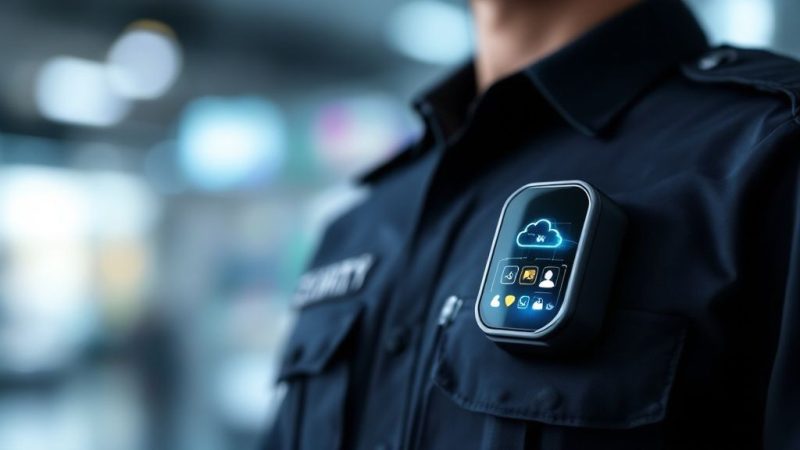Body Cameras for Security A Practical Guide
At their core, body cameras for security are pretty straightforward: small, wearable devices that record audio and video. But what they really do is provide an unbiased account of every interaction between your team and the public. Think of them as an impartial witness, capturing events exactly as they unfold. This simple piece of tech is shifting the entire security model from reactive to proactive, and it's quickly becoming a non-negotiable tool for modern teams.
How Body Cameras Are Redefining Modern Security
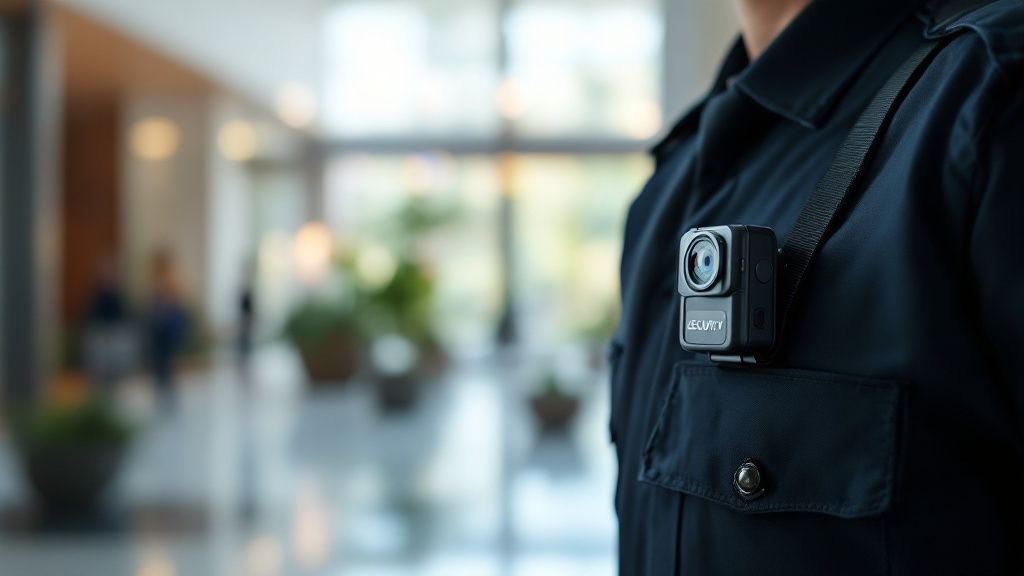
Running a security team without body cameras is a bit like asking a referee to recall a split-second play purely from memory—it’s always going to be open to interpretation and human error. Body-worn cameras change all that by providing undeniable, real-time footage that serves as the single source of truth.
This isn't just about reacting to incidents after they happen. It’s about arming your team with objective evidence that can de-escalate confrontations before they even start, protect personnel from false accusations, and frankly, build a lot more trust with the public.
The Core Benefits of Body-Worn Technology
The value of body cameras goes way beyond just hitting "record." They create a ripple effect of accountability and professionalism that can be felt throughout an entire organization. Some of the biggest advantages include:
- Incident De-escalation: You’d be surprised how much behavior changes when people know they're being recorded. For example, a security officer at a nightclub asks a rowdy patron to leave. The patron becomes verbally aggressive, but upon hearing the officer state, "Sir, this interaction is being recorded," their demeanor often changes, preventing a physical altercation. The simple, visible presence of a camera encourages everyone to stay calmer, which helps stop conflicts from spiraling out of control.
- Enhanced Training Opportunities: Forget generic training videos. Real-world footage is an incredible training tool. Actionable Insight: A successful de-escalation captured on camera can become the gold standard for teaching new hires. Instead of paying for expensive third-party training courses, you can build an in-house library of best-practice videos, saving you thousands in training budgets.
- Reduced Liability and Complaints: Video evidence is your best friend when a claim is filed against your staff. It can instantly verify or disprove allegations, which dramatically cuts down on the time and money spent on investigations and can even help lower your insurance premiums.
A Growing Market Driven by Accountability
The move toward body cameras is happening fast, and it reflects a worldwide demand for more transparency. The global market for body-worn cameras hit USD 1.3 billion in 2023 and is on track to reach about USD 8.5 billion by 2025. This explosion is fueled by the tech's proven track record for creating accountability, plus new advancements like 4K streaming and AI analytics. You can dig into more details about the body-worn camera market to see where things are headed.
A body camera program isn’t just an expense; it’s an investment in risk management. The cost of a single unsubstantiated lawsuit can easily exceed the cost of deploying cameras for an entire team.
Imagine this: a retail security guard activates their camera during a tense interaction with a suspected shoplifter. That recording doesn't just document the event for potential legal action; it also encourages the guard to stick to their training and might convince the individual to think twice before getting aggressive. What you're left with is an unbiased record that’s invaluable for incident reviews and any legal proceedings, setting the stage for a security operation that's not just more effective, but also more trusted.
Choosing the Right Body Camera System
Picking the right body camera system can feel overwhelming, but it really just boils down to matching the right features to what your team actually does day-to-day. It’s easy to get lost in a checklist of specs, but you have to think about the practical impact. It’s like picking a vehicle for your patrols—you wouldn't buy a sports car to cover rugged, off-road terrain.
The hardware you choose is the foundation of your entire program. Getting it right from the start means your team has a tool they can depend on when things get critical, saving you from a lot of costly headaches down the road.
Decoding Key Hardware Specifications
Let's be clear: not all body cameras are created equal. A few key specs can be the difference between capturing crystal-clear evidence and ending up with a blurry, useless recording. You have to look past the numbers and understand the why behind them.
-
Battery Life (e.g., 12+ hours): A long battery life isn't just a nice-to-have; it's a huge operational advantage. A camera that can run for a full 12-hour shift means no more mid-shift device swaps. Actionable Insight: This eliminates the need to purchase, inventory, and manage a second set of batteries and chargers for every officer, directly reducing equipment overhead costs.
-
Video Resolution (e.g., 1080p vs. 4K): While 1080p is pretty standard these days, stepping up to 4K can be a real game-changer. Think about trying to identify a license plate from a distance or picking out small details in a poorly lit area. That extra bit of clarity can turn shaky footage into concrete proof.
-
Durability (IP Rating): You’ll see ratings like IP67 on spec sheets. This tells you exactly how tough the device is against dust and water. For example, a security team patrolling an outdoor music festival in the rain won't have to worry about equipment failure, saving you from having to constantly replace gear that's been damaged by the elements.
-
Field of View (FOV): A wider FOV, like 140 degrees, captures more of the scene. This is vital when you're reviewing an incident because it gives you the full context of what was happening on the periphery, not just what was directly in front of the officer.
The infographic below really drives home why getting these specs right matters. It shows the kind of measurable improvements organizations see after they roll out a solid body camera program.
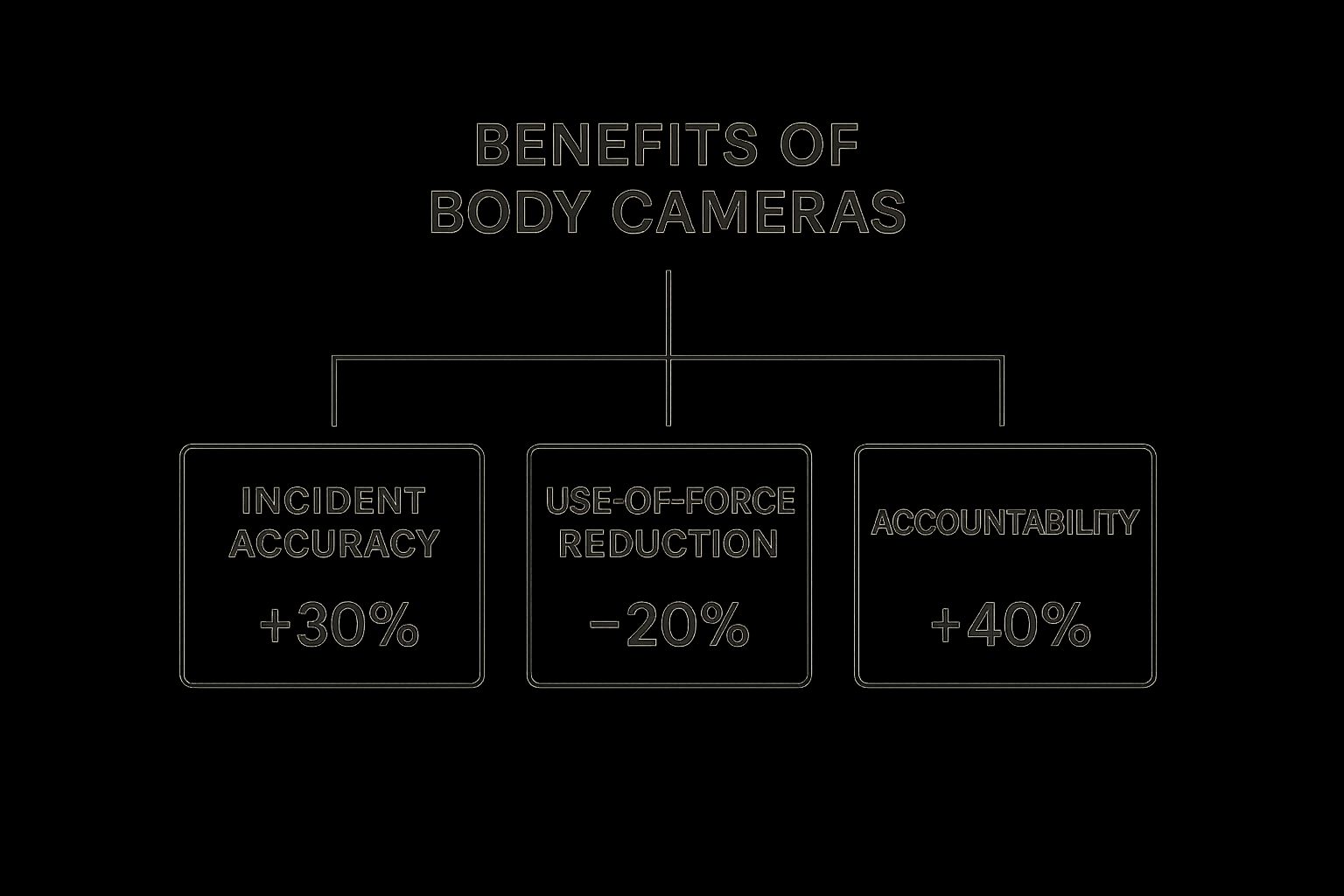
This data isn't just numbers on a chart. It shows real gains in accountability, accuracy, and de-escalation—all things that are directly supported by high-quality, reliable video footage.
The Software Brains Behind the Camera
A camera is just one piece of the puzzle. The software that manages all that footage—often called a Digital Evidence Management System (DEMS)—is what turns raw video into secure, manageable evidence that holds up in court. Without a solid DEMS, you're basically just creating huge video files with no secure way to store, track, or use them.
A DEMS is the digital equivalent of a secure evidence locker. It protects the integrity of your footage from the moment it's recorded to the moment it's presented in court, ensuring an unbreakable chain of custody.
When you're looking at software, you need to focus on things like secure cloud storage, automated redaction tools (to protect privacy), and detailed audit logs. These aren't just fancy add-ons; they are essential for legal compliance and keeping your operations efficient.
The market is definitely responding to this need. Between 2024 and 2030, the global body camera market is projected to jump from around USD 363.6 million to approximately USD 1.2 billion. That’s a growth rate of about 20.7% every year, driven by the demand for better accountability and new tech like AI-powered analysis. You can learn more about the global body camera market growth to see where things are headed.
To help you sort through the options, this table breaks down the features you might find at different levels, from basic setups to enterprise-grade systems.
Essential Body Camera Feature Comparison
This table compares critical hardware and software features to help security managers make an informed purchasing decision based on their operational requirements and budget.
| Feature | Basic (Cost-Saving) | Professional (Balanced) | Enterprise (Advanced) |
|---|---|---|---|
| Video Resolution | 1080p Standard HD | 1080p/2K QHD | 4K UHD with advanced low-light sensors |
| Battery Life | 8-10 hours (may require mid-shift swap) | 12+ hours (full shift coverage) | 14+ hours with hot-swappable batteries |
| Durability (IP) | IP65 (dust tight, water jet resistant) | IP67 (dust tight, waterproof up to 1m) | IP68 (dust tight, continuous immersion) & MIL-STD-810G |
| Storage | Local device storage, manual offload | Secure cloud storage with automated upload | Geo-redundant cloud storage, automated retention policies |
| Evidence Management | Basic file tagging and search | Automated redaction, chain of custody logs | AI-powered search, real-time streaming, case management |
| Integration | Standalone system | CAD/RMS integration capabilities | Full integration with dispatch, VMS, and access control |
Ultimately, the best system is the one that fits your team's workflow and budget. A smaller team might do fine with a professional-tier setup, while a large-scale operation with complex compliance needs will get more value out of an enterprise solution.
Smart Ways to Save Money on Your System
Rolling out a body camera program doesn't have to drain your budget. If you're strategic about it, you can get all the capabilities you need without overspending.
One of the smartest moves is to find a vendor with a scalable cloud storage plan. Instead of paying for a ton of storage you don't need right away, you can start with a smaller plan and grow as your team and data volume increase. This "pay-as-you-go" approach stops you from wasting money on empty server space.
Another tip is to look for bundled deals. A lot of vendors will package their hardware, software licenses, and support together for a much better price than if you bought everything separately. This not only cuts down the initial cost but also makes purchasing simpler and guarantees everything works together seamlessly.
Getting Your Body Camera Program Off the Ground
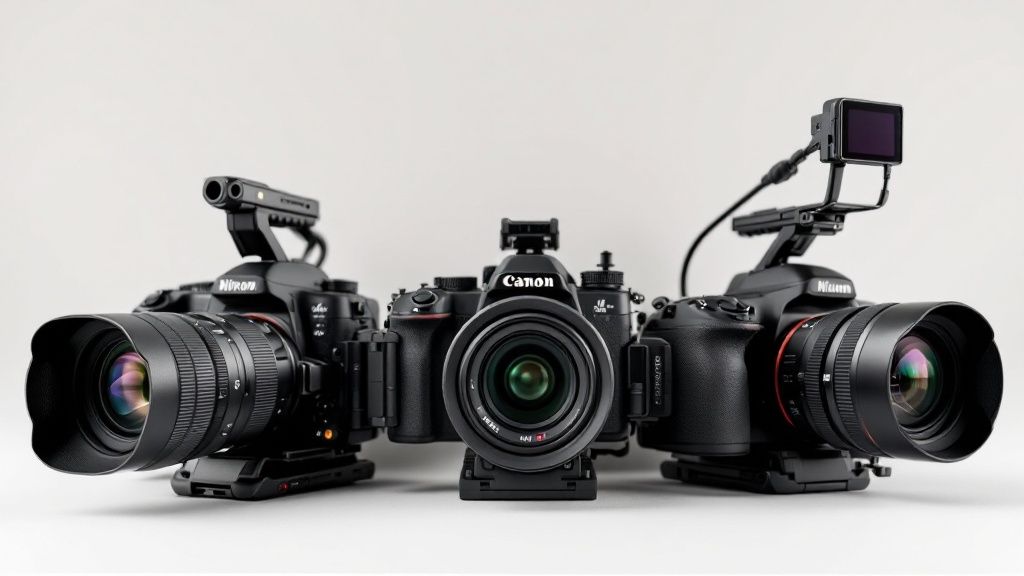
Buying the right cameras and software is really just the first step. A truly successful body camera program lives or dies by its implementation. It’s about much more than just handing devices to your security team. Without clear rules of the road and practical training, even the best tech will end up collecting dust.
The absolute foundation of any deployment is a clear, comprehensive usage policy. Think of this document as the official rulebook for your entire team. It gets rid of the guesswork and keeps everyone on the same page. It needs to spell out exactly when recordings start and stop, how long different types of footage are kept, and who has the keys to access, view, or share that footage.
For instance, your policy might require an officer to hit record anytime they're in a confrontational situation but strictly forbid recording in private spaces like restrooms. That kind of clarity is what protects both the public and your own people.
Building Confidence Through Practical Training
Training is where your policy stops being a document and becomes a real-world tool. It's not enough for officers to just read a manual. They need to get their hands on the cameras, build that muscle memory, and gain the confidence to use them effectively when the pressure is on. A generic PowerPoint presentation just isn't going to cut it.
The best training programs are built around practical, scenario-based exercises. You can stage role-playing drills that mimic the common incidents your team actually faces, like handling an aggressive person or documenting a trespasser. This gives officers a chance to practice hitting record, announcing that a recording is active, and de-escalating the situation—all in a controlled setting. Afterward, the team can watch the footage together to talk about what went right and what could be done better next time.
Nailing the Technical Setup
Alongside solid policies and training, the technical side of your program has to be seamless. Think through the day-to-day workflow. At the end of a shift, where do the cameras go to charge? A centralized, multi-bay charging station is usually the most efficient way to go, making sure every device is juiced up and ready for the next shift.
You also need to figure out how your body cameras will play with your existing systems. Connecting them to your dispatch software, for example, can unlock some powerful automations. You could have a camera automatically start recording the second an officer is dispatched to a high-priority call. If you have questions about managing these kinds of integrations, you can get some great info by checking out our guide on Resgrid’s support and implementation processes.
The real goal here is to make using the body cameras a natural, ingrained part of your team's routine, not some clunky afterthought. When the logistics are smooth, it just removes the friction and makes consistent use a whole lot easier.
The Phased Rollout: A Smart, Cost-Saving Strategy
One of the smartest ways to manage costs and ensure a smooth launch is with a phased rollout. Instead of giving cameras to your entire force all at once, start with a small pilot group. This approach has some major financial and operational perks.
- Managed Upfront Investment: You get to spread out the initial hardware and software costs over time, which is a lot friendlier to your budget.
- Policy Refinement: Your pilot group will almost certainly run into situations you hadn't planned for. Their feedback is a low-risk way to fine-tune your usage policies and training before you go all-in.
- Identify Technical Glitches: It's much easier to troubleshoot technical issues, like quirks with charging stations or software bugs, with a smaller test group.
By starting small, you can iron out all the kinks and build a model that you know works. This keeps you from making expensive, large-scale mistakes and helps ensure that when you do roll the program out to everyone, it runs like a well-oiled machine from day one.
This strategic approach is becoming the norm as body cameras see wider use in security. In 2024, the global market was valued at USD 1.65 billion and is projected to climb to USD 4.25 billion by 2034. That growth is being fueled by a rising demand for transparency and better evidence collection across all kinds of industries.
Using Footage for Proactive Team Improvement
The real power of body cameras isn't just capturing evidence after something goes wrong. It's about using that footage to build a smarter, safer, and more effective team.
When you shift your focus from purely reactive incident reviews to proactive operational improvement, your camera system stops being a simple recording device. It becomes a powerful coaching tool. This approach creates a cycle of constant learning and refinement, unlocking a continuous return on your investment.
It's all about moving beyond asking, "What happened?" and starting to ask, "How can we do better next time?" This mindset turns every single recorded interaction—good or bad—into a genuine learning opportunity for your entire security force.
Transforming Footage into Actionable Training
Your archive of body camera footage is a goldmine of real-world training material. It’s far more impactful than any generic, scripted video you could buy. You can pull specific interactions and turn them into best-practice examples that show your team exactly what excellence looks like in the field.
Practical Example:
Imagine an officer successfully de-escalates a tense situation at a retail location. Instead of that win remaining an isolated event, you can use the footage as the centerpiece of a training module. This gives your entire team a clear, practical demonstration of effective communication and conflict resolution. This in-house approach not only saves thousands on external trainers but also delivers content that's perfectly tailored to the challenges your team faces every day.
Objective Performance Reviews and Feedback
Let's be honest, performance reviews can get bogged down by subjective opinions and "he said, she said" arguments. Body camera footage cuts right through the noise, providing an objective, unbiased record of an officer's conduct.
When an event is handled poorly, the footage offers a clear path for constructive feedback. A manager doesn't have to rely on secondhand information. They can sit down with the officer and review the recording together, creating specific, teachable moments. For instance, a manager could point to the exact moment an officer’s body language became confrontational and talk through alternative approaches. This data-driven coaching is simply more effective and is often received better because it’s based on facts, not feelings.
Using body camera footage for performance reviews isn't about catching people making mistakes. It's about creating a culture of accountability and continuous improvement where objective feedback helps everyone grow professionally.
This isn't just theory; it's being put into practice. Walmart recently started a pilot program testing body cameras for security on store employees, not for catching thieves, but specifically for the safety of its workers. Similarly, TJX, the parent company of TJ Maxx and Marshalls, equipped its security staff with cameras to help de-escalate incidents and show a serious commitment to safety.
Using Data to Refine Strategy and Save Money
Looking beyond individual incidents, aggregating the data from all your body camera footage can reveal powerful operational patterns. By analyzing video metadata, you can spot trends that let you allocate resources more intelligently, which translates directly into cost savings.
-
Identifying High-Incident Zones: Does footage show a recurring pattern of trouble near a specific entrance or during certain hours? For example, a hospital security team might find that 70% of their confrontational incidents occur near the emergency room entrance between 10 PM and 2 AM. This data allows you to strategically increase patrols in that area at peak times, preventing incidents before they even start.
-
Optimizing Staffing Levels: Your analysis might reveal that incidents are extremely rare during certain shifts. That insight could allow you to adjust staffing schedules, cutting unnecessary labor costs without compromising security.
-
Evaluating Equipment and Tactics: Does footage consistently show officers fumbling with a piece of equipment or struggling with a specific protocol? This provides clear evidence that a process needs updating or that more training is required.
By looking at the bigger picture, you can make informed decisions that improve overall efficiency. This data-driven strategy ensures your security force is always in the right place, at the right time, with the right training—turning your body camera system into a critical asset for strategic planning.
Navigating Privacy Laws and Legal Compliance
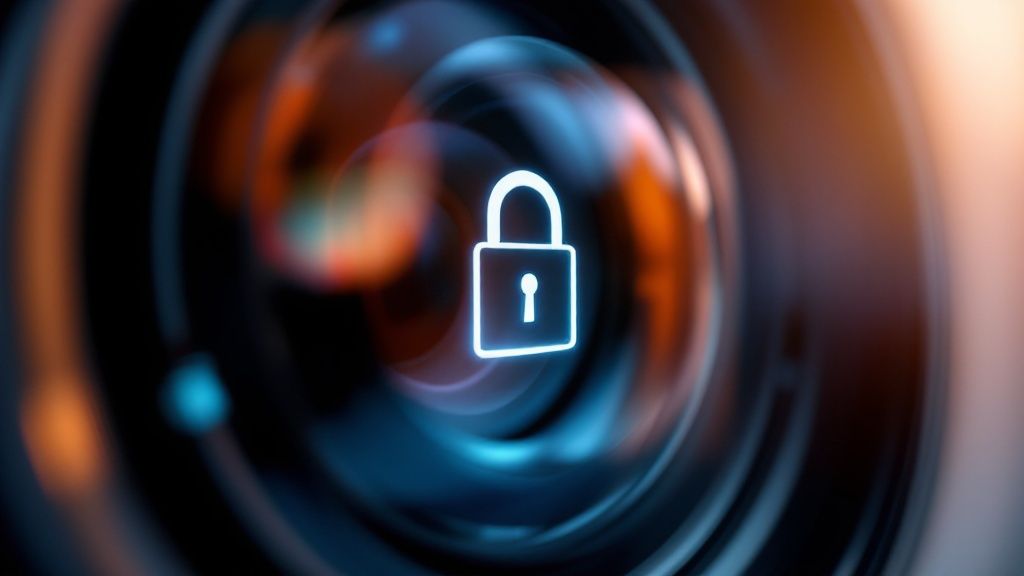
Putting body cameras for security into play is a huge step for transparency and accountability. But with great power comes great responsibility—specifically, the responsibility to handle a ton of sensitive data the right way. Getting tangled in the web of privacy laws isn't optional; it's an absolute must if you want to keep your organization out of hot water.
Ignoring regulations like the General Data Protection Regulation (GDPR) in Europe or the California Consumer Privacy Act (CCPA) can lead to fines that make your camera system look cheap. These laws give people rights over their personal data, and video footage of them absolutely counts.
When you get this right, legal compliance stops being a liability and becomes a foundational strength of your entire security program.
Building a Privacy-First Policy
Your first move should be to hammer out a clear, practical privacy policy for your body camera program. This document needs to spell out not just when to record, but also where recording is completely off-limits. Think of these as designated "privacy zones."
For example, a common-sense rule is to ban all recording in places like restrooms, employee break rooms, or medical areas. It’s a simple but effective way to avoid accidental privacy breaches and show everyone you’re serious about ethical data collection. The key is to make your policy so clear that every single person on your team gets it.
Think of your privacy policy as the guardrails for your body camera program. It keeps your team operating safely within legal boundaries, protecting both the public and your organization from unnecessary risk.
Beyond just physical spaces, your policy has to cover how the data is handled digitally. This means setting strict data retention schedules. Footage that’s no longer needed for evidence or training has to be deleted securely and automatically. Hoarding data forever just creates a mountain of unnecessary risk. For a good rundown of what’s expected from modern businesses, this essential guide to data privacy compliance is a solid read.
The Cost-Saving Power of Automated Redaction
One of the biggest headaches in compliance is protecting the identities of bystanders who just happen to be in the frame. Manually blurring out faces, license plates, and other personal info from hours of video is a soul-crushing, expensive task. It can easily take several hours for a person to properly redact just one hour of footage.
This is where a modern Digital Evidence Management System (DEMS) becomes a game-changer. These systems use AI-powered automated redaction software to spot and obscure sensitive information with a few clicks.
Actionable Insight to Save Money:
Instead of paying a staff member for 10+ hours to manually edit a single incident video, automated redaction software can often complete the same task in minutes. This frees up hundreds of hours of labor annually, allowing your team to focus on security tasks rather than tedious video editing.
Maintaining an Unbreakable Chain of Custody
When your body camera footage ends up as evidence, its integrity is everything. You have to be able to prove, without a doubt, that the video file hasn't been touched or tampered with from the second it was recorded. This legal concept is called the chain of custody.
If your chain of custody is weak, your most critical piece of evidence can be thrown out in court. That completely defeats the purpose of having the camera in the first place. Trying to manually log every single interaction with a video file is just asking for human error.
Modern DEMS platforms solve this by creating an automatic, tamper-proof audit trail. Every single action—uploading, viewing, sharing, redacting, exporting—is logged with a timestamp and user ID. This digital log acts as an unbreakable chain of custody, ensuring your evidence holds up under legal scrutiny. The system automates what would otherwise be a massive administrative burden, saving time and plugging major legal holes. You can check out our own commitment to data integrity by reading Resgrid’s privacy policy and practices.
Integrating Body Cameras Into Your Security Ecosystem
A body camera is a great tool, but it really shines when it’s not just an isolated piece of tech. The real magic happens when your cameras become a seamless part of your entire security operation, acting as a force multiplier for every other system you have in place.
Think of it like a sports team. A star player is fantastic, but the team only wins when everyone is communicating and working together. In the same way, your body cameras become exponentially more powerful when they’re fully integrated with your central command and dispatch systems.
Creating a Connected Security Network
The goal here is to build a unified ecosystem where information flows freely between your different platforms. This gives your command center a complete, real-time picture of any situation as it unfolds, moving your team from simply reacting to incidents to proactively managing them with better intelligence.
A perfect example of this is tying your body cameras into a Computer-Aided Dispatch (CAD) system. This connection can automate critical actions and cut out the risk of human error when every second counts.
- Here's how it works: A dispatcher creates a high-priority call in the CAD. That action can automatically trigger the assigned officer's body camera to start recording. This simple automation ensures the crucial moments leading up to an engagement are never missed just because an officer, in a high-stress moment, forgot to hit a button.
Another powerful hook-up is with your existing Video Management System (VMS). This integration gives your command center the ability to pull up live body camera streams right alongside the feeds from your fixed CCTV cameras. For a deeper look at how dispatch systems can pull all of your operations together, you can find valuable insights on managing security and first responder logistics.
The Financial Sense of Open APIs
Getting this level of integration might sound complicated and expensive, but it doesn't have to be. The secret is choosing a body camera system built with an open Application Programming Interface (API). An API is basically a universal translator that allows different software programs to talk to each other.
Actionable Insight to Save Money:
Picking a system with an open API is one of the biggest cost-saving decisions you can make. It lets you use your existing software and avoid shelling out tens of thousands of dollars for custom development or getting locked into a single vendor's pricey, proprietary ecosystem.
This open approach also future-proofs your investment, giving you the flexibility to connect your cameras with other tools as your needs change down the road. When you're thinking about integration, it’s also important to consider how body cams complement your existing setups, like commercial alarm monitoring services. A truly connected ecosystem ensures every piece of your security puzzle works together to keep your people and assets safe.
Common Questions About Body Cameras for Security
When you start looking into body cameras for security, a few practical questions always come up. Getting straight answers to these is the key to making a smart investment and building a program that actually works from day one.
How Much Data Will We Generate and What Will Storage Cost?
This is usually the first thing on everyone's mind. A single officer can easily rack up 1-2 GB of video data per shift. Multiply that across your team, and you can see how storage becomes a huge piece of the puzzle.
These days, cloud-based Digital Evidence Management Systems (DEMS) are the standard for a reason. They offer plans that scale right alongside your needs.
Actionable Insight to Save Money:
Don't overbuy on storage. Start with a smaller plan and only upgrade when you actually need it. The other big money-saver is a solid data retention policy. Automatically purging routine footage after a set time, say 90 days, will dramatically cut your long-term storage bill.
Think about it: a security firm could start with a 1 TB plan and just keep an eye on usage. If they’re using less, they’re saving cash. If they need more, they can scale up without a massive upfront cost.
Will Security Officers Be Resistant to Using Body Cameras?
It’s a fair question. The truth is, you might get some initial pushback, but it’s almost always manageable if you approach it the right way. The key is to frame the cameras as a tool for their protection, not just another way for management to watch them.
Nothing shuts down a false complaint faster than an unbiased recording. That’s a powerful benefit for any officer. To really get them on board, bring them into the process of creating the usage policy. This gives them a real sense of ownership and makes sure the rules are practical for the situations they face every day.
Can Body Camera Footage Be Tampered With?
Professional-grade body cameras for security are built like a fortress to prevent tampering. Right from the get-go, footage is encrypted on the device itself before it’s securely uploaded to the DEMS.
These systems are designed to maintain an automated and unbreakable chain of custody. Every single time someone interacts with a video file—whether it's viewing, sharing, or redacting a clip—it’s logged in a tamper-proof audit trail. This is what gives your footage integrity and makes it solid, admissible evidence if you ever need it in court.
At Resgrid, LLC, we build the dispatch and management tools that keep your security operations running like a well-oiled machine. Our platform makes it easy to integrate new technologies like body cameras into a single, unified system. See how we can support your team by visiting https://resgrid.com.

